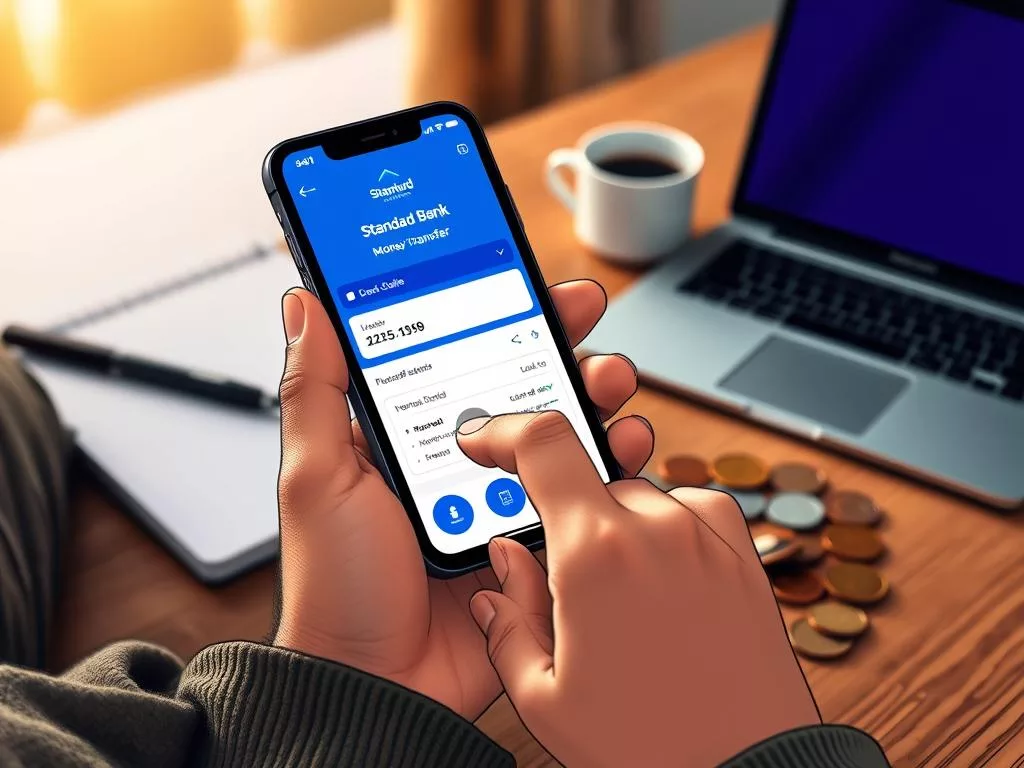In today’s world, knowing how to send money across borders is key. This guide is about Standard Bank’s services for international money transfers. It makes sure your payments are safe, fast, and clear.
We’ll cover how to start transfers and get money from abroad. You’ll learn about banking solutions that fit your needs. Also, we’ll talk about how to understand exchange rates and fees. This will help you handle international money moves with ease.
Standard Bank helps non-residents with accounts and loans, even if you’re not in South Africa. For more on affordable banking and what you need, check out efficient payment solutions. We’ll show you how to send money abroad and share important tips and things to think about.
Understanding International Payments with Standard Bank
International payments are key in global trade, letting businesses deal with each other worldwide. Standard Bank systems offer foreign exchange solutions for these transactions. They usually take two business days, making it easier for everyone involved.
Standard Bank has a checklist for cross-border payments. It covers three main steps to help with these transactions. For those making fewer than 15 payments a year, Online Banking is great. It’s perfect for amounts under R 1.5 million.
Businesses with bigger needs can use Business Online. It allows unlimited transactions and handles larger amounts.
Exchange control rules often complicate international payments. These rules can change, and businesses might need Reserve Bank approval for some transactions. The fees for telegraphic transfers vary too. Online transfers cost 0.5%, while branch transfers are a bit more.
Feedback on complex transactions usually comes within five business days. This keeps clients in the loop. Standard Bank has many digital payment options to meet different business needs. This makes international payments more efficient.
Guide to International Money Transfers Standard Bank South Africa
Standard Bank South Africa offers a detailed guide for sending money abroad. To start, you need to gather important documents. This includes the recipient’s name, address, and bank details like IBAN and BIC or SWIFT codes.
It’s important to know about exchange control rules. You must fill out a Balance of Payments (BoP) code form. This form matches the payment’s purpose. Standard Bank provides a step-by-step guide to help you follow these rules. If you’re new to these terms, there’s a glossary and FAQs to help.
Before sending money, check the exchange rates and costs. This helps you make smart choices about when and how much to send. If you have questions, the Foreign Exchange team is ready to help. You can reach them through the Standard Bank app or internet banking.

Once you’ve sent money, you can track its status online or by contacting Standard Bank. The bank offers several ways to make international payments. This includes the Shyft Global Wallet and Bureau de Change branches.
| Service Type | Features | Access Channels |
|---|---|---|
| International Money Transfer | Send funds overseas, currency conversion, transaction transparency | Standard Bank app, internet banking, in-branch assistance |
| Foreign Currency Lending | Conversion-free solutions, structured investment products | Online platform, financial advisors |
| Regulatory Support | Ongoing reporting, compliance with exchange control regulations | Dedicated foreign exchange team, client services |
For more details on the payment process, visit the international payments page. This page helps you understand international banking better.
How to Initiate an International Money Transfer
Starting an international money transfer with the Standard Bank app or Internet Banking is easy. If you use the Standard Bank app, here’s what to do:
- Open the Standard Bank app on your device.
- Select the ‘Outward International Payments’ option from the menu.
- Fill in the required recipient details, including their bank information and transfer amount.
- Review all information carefully to ensure accuracy.
- Confirm the transaction to initiate your international transfer.
If you prefer Internet Banking, the steps are similar:
- Log into your Standard Bank Internet Banking account.
- Choose the ‘International Payment’ option.
- Enter the necessary recipient information and amount to be transferred.
- Double-check the details for correctness.
- Submit the request to complete your international transactions.

International money transfers usually take 1-5 business days. Remember, fees might apply. Standard Bank charges a fixed fee of $30 to $50. Intermediary banks might also charge extra fees. Always check the costs to save money.
Receiving Payments from Abroad with Standard Bank
Receiving international payments through Standard Bank requires the right information. Both individuals and businesses need to give their Standard Bank account details. This includes the account number, universal branch code, and SWIFT code.
This info is key for the sender to make the transfer. Recent changes by the South African Reserve Bank affect EFTs to countries like Namibia, eSwatini, and Lesotho.
For personal customers sending money to these Common Monetary Area (CMA) countries, you can visit Forex branches of Standard Bank. You’ll need a SWIFT application form and the Balance of Payment Code. The BOP code is important for processing payments and can be found in a guide.
Business clients must fill out a Balance of Payment form and submit a payment request for international transactions. Standard Bank offers practical guidance to help customers through these changes. For more help or a step-by-step guide on managing international payments, contact a Relationship Banker or check online resources.

